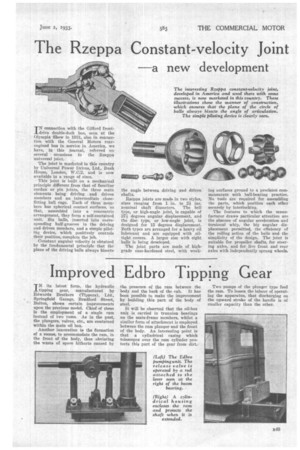The Rzeppa Constant-velocity Joint
Page 67

If you've noticed an error in this article please click here to report it so we can fix it.
a new development
IN connection with the Gifford frontdrive double-deck bus, seen at the Olympia Show in 1931, also in connection with the General Motors rearengined bus in service hi America, we have, in this journal, referred on several occasions to the Rzeppa
universal joint. .
The joint is marketed in this country by Universal Power Drives, Ltd., Bush House, London, W.C.2, and is now available in a range of sizes.
This joint is built on a mechanical principle different from that of familiar cardan or pin joints, the three main elements being driving and driven members and an intermediate closefitting ball Cage. Each of these members has spherical contact surfaces; so that, assembled into a concentric arrangement, they form a self-contained unit. Six balls, inserted into corresponding half-grooves in the driving and driven members, and a simple piloting device, which positively controls their position, complete the job. Constant angular velocity is obtained by the fundamental principle that the plane of the driving balls always bisects the angle between driving and driven shafts.
Rzeppa joints are made in two styles, sizes ranging from 1 in. to 2i ins. nominal shaft diameters. The bell type, or high-angle joint, is capable of 37i degrees angular displacement, and the disc type, or low-angle joint, is designed for 15 degrees displacement. Both types are arranged for a heavy oil lubricant and are equipped with oiltight covers. A larger size with eight balls is being developed.
The joint parts are made of highgrade case-hardened steel, with work
lag surfaces ground to a precision comMensurate with ball-bearing practice. No tools are required for assembling the parts, which position each other securely by interlocking.
The features to which the manufacturer draws particular attention are the absence of angular acceleration and torsional whip, the big angular displacement permitted, the efficiency of the rolling action of the balls and the simplicity of the design. The joint is suitable for propeller shafts, for steering axles, and for live front and rear axles with independently sprung wheels.




































































































